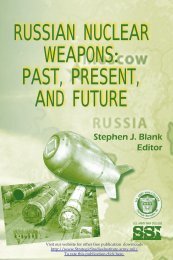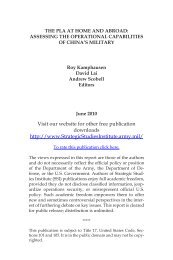The United States and China in Power Transition - Strategic Studies ...
The United States and China in Power Transition - Strategic Studies ...
The United States and China in Power Transition - Strategic Studies ...
You also want an ePaper? Increase the reach of your titles
YUMPU automatically turns print PDFs into web optimized ePapers that Google loves.
In addition to these quantitative changes, <strong>Ch<strong>in</strong>a</strong><br />
has also brought about qualitative transformation<br />
through the implementation of the RMA to its military<br />
organization, comm<strong>and</strong> <strong>and</strong> staff, doctr<strong>in</strong>e, education,<br />
logistics, medical support, defense <strong>in</strong>dustries, <strong>and</strong><br />
many other areas. In recent years, the Ch<strong>in</strong>ese military<br />
has also put its new capabilities <strong>and</strong> improved<br />
war mach<strong>in</strong>es to test <strong>in</strong> frequent military exercises <strong>in</strong>side<br />
<strong>Ch<strong>in</strong>a</strong> as well as with foreign militaries abroad. A<br />
more capable military force is unquestionably emerg<strong>in</strong>g<br />
<strong>in</strong> <strong>Ch<strong>in</strong>a</strong>. 227 Rid<strong>in</strong>g the tides of its transformation<br />
<strong>and</strong> development, <strong>Ch<strong>in</strong>a</strong>’s military is now eager to<br />
carry out its new mission <strong>in</strong> the new century, which<br />
<strong>in</strong> good part will be <strong>in</strong> contact <strong>and</strong> conflict with the<br />
<strong>United</strong> <strong>States</strong>. 228<br />
This leads us to f<strong>in</strong>d answers to the question of<br />
how the Ch<strong>in</strong>ese <strong>and</strong> U.S. militaries get along <strong>in</strong> this<br />
ongo<strong>in</strong>g power transition between the two nations. As<br />
discussed earlier, neither side wants a war with the<br />
other. Yet the <strong>United</strong> <strong>States</strong> <strong>and</strong> <strong>Ch<strong>in</strong>a</strong> have plenty of<br />
conflict that can drive the two <strong>in</strong>to unwanted confrontations.<br />
It is imperative that the two sides f<strong>in</strong>d ways<br />
to m<strong>in</strong>imize the dangers. <strong>The</strong> <strong>United</strong> <strong>States</strong> <strong>and</strong> <strong>Ch<strong>in</strong>a</strong><br />
presumably can take many different measures to<br />
avoid un<strong>in</strong>tended confrontations, but the most basic<br />
one is arguably to establish an effective, reliable, <strong>and</strong><br />
stable contact between the two militaries. It is quite<br />
a problem that more than 30 years after establish<strong>in</strong>g<br />
normal relations, the two nations still have not found<br />
the way to do the same for the most sensitive component<br />
of their national power, the military.<br />
<strong>The</strong> reasons, <strong>in</strong>congruously, are simple. <strong>The</strong> two<br />
sides have <strong>in</strong>compatible views about the problems <strong>in</strong><br />
their military relations <strong>and</strong> <strong>in</strong> the words of Ch<strong>in</strong>ese<br />
193

















